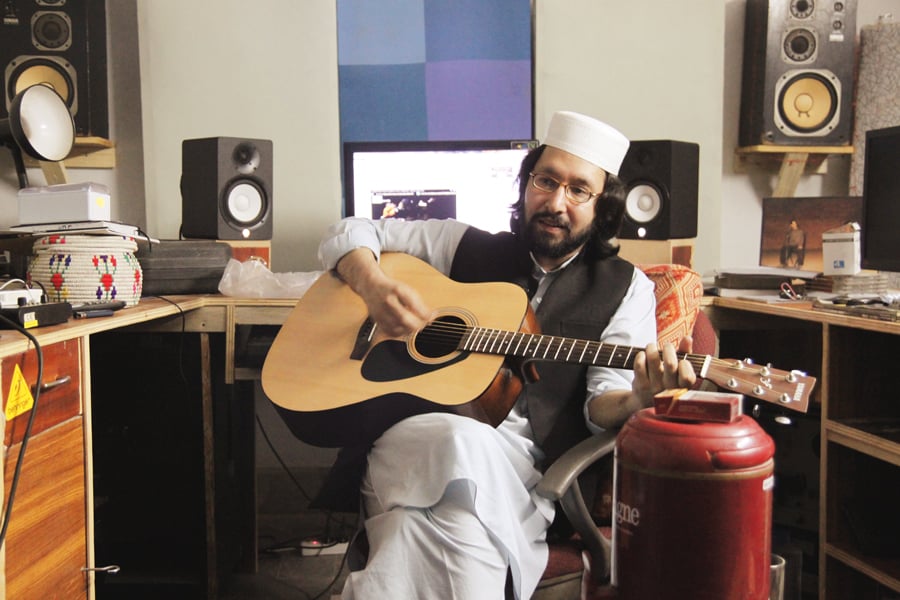
Two days before my flight to Peshawar, I was asked to write a profile about a musician based in the city. All I was told was that he looked a lot like John Lennon. And he did.
When I stepped out of the car to meet Rahim Saranjam Khan, however, I was slightly taken aback. I had imagined a tall, lanky man with long hair wearing a fireman coat and about to break into a song from Sgt Pepper’s Lonely Hearts Club. Instead, I met someone dressed in a light blue shalwar kameez, black waistcoat and a taqiyah on his head. After an awkward introduction, where I was trying to assimilate the situation and rework the questions I had prepared, Khan laughed and said, “Don’t be alarmed. The outfit is part of a social experiment.”

We walked down the stairs to Khan’s basement — a small room almost at the far end of the house which he has converted into a studio. A place, he says, he rarely leaves these days except to go to work.
Even after studying at Aitcheson College, Lahore, the Institute of Business Administration in Karachi and spending some time living in Islamabad, Rahim came back to his studio basement at home.
Rahim was first brought on to the scene by the second season of Uth Records in 2012, as their closing act. His original composition, Afsoos, an adaptation of poet Ahmed Faraz’s work was something that blew everyone away. More importantly, he was also a part of the sudden influx of musicians from Khyber -Pakhtunkhwa that started with the first episode of Uth Records, when Yasir & Jawad released Reidi Gul.
Uth Records was an interesting experience for Rahim, being the only musician from Peshawar to be featured on the show. How did he get selected? “There are a handful of musicians in this city and if one of the big guys (Gumby or Zeeshan) hears your stuff, you get selected,” he explained.
He wasn’t very impressed by the eligibility criteria of the show and according to some friends, not very happy with the way his song was treated in the show.
However, Uth Records was also the last time that he performed, because a few days after his performance, Youtube was banned. “People used to have free access to our music; on mainstream television and radio channels you need to know people,” said Rahim.
Therefore, these days his focus is on producing music for others rather than playing it live, he is currently busy making some fusion music that doesn’t only invovle merging rabab and guitar. His big experiment is about merging the sound of the West with that of the East, so one should be prepared to hear some rabab, guitar, chirtali sitar, tabla and tarbooka. He has put his Urdu album on hold and is working with another musician on reworking old Pashto songs.
Rahim was always interested in music. He was 12 years old when he asked his grandfather to bring him a guitar from the US, however, that didn’t happen. When he turned 16, his uncle gave him a guitar and that started a journey that still continues. “Nobody taught me how to play,” he said. “For the longest time I didn’t even have a guitar. You know when teenagers start out, they want to be stars. They look at the Grammys and Oscars and start fantasising, similarly, I had started fantasising.”
After his debut performance at a school show — The Gentlemen of Aitcheson, where he performed Outside by Staind, with a friend, he felt they could do anything. “It was a very memorable night. We were just average Joes, but everyone clapped after the song was over. We were sure we were about to get famous,” he said.
The 29 year old has been playing music since 2000. He started with classical and then heavy-metal rock, but has now discovered a favourite — a fusion of eastern and western. “Indian music is a mixture of folk developed into raags,” he said. “Western music on the other hand is based more on harmony. What we are trying to do is take that folk music and put some chords on it.”
The social experiment
“When people see me, they go into a shock, they think I have turned,” he said referring to how his look has changed from being clean shaven and in western clothes to someone with a beard and always dressed in shalwar kameez. “
Rahim explained that the idea of identity became important to him when he moved back to Peshawar. “At the end of the day I am a Pukhtun. I don’t want to lose my identity. The kind of schooling and upbringing I have had, I was being trained to become a brown sahib, which I am not,” explained Rahim.
Moving back to Peshawar made him realise that he wanted to go back to his roots. “I was like, why am I dreaming about the Grammys? And this, is what the look is about,” he concluded.
Bet you didn’t know
During the day Rahim works as a monitoring evaluation officer at an NGO, a boring job but something, he says, has helped him mature quickly. Other musicians say that Rahim has evolved. One said that he used to be a musician, but now he is an Ustaad. His sound is also very unique — a Pink Floyd/Indian Classical fusion. Not only did he learn to play the guitar himself, Rahim also taught himself opera singing.
Published in The Express Tribune, April 28th, 2014.
Like Life & Style on Facebook, follow @ETLifeandStyle on Twitter for the latest in fashion, gossip and entertainment.
COMMENTS (5)
Comments are moderated and generally will be posted if they are on-topic and not abusive.
For more information, please see our Comments FAQ



1732263441-0/BeFunky-collage-(81)1732263441-0-165x106.webp)
1732263755-0/musk-(3)1732263755-0-165x106.webp)
1732267954-0/Express-Tribune-(6)1732267954-0-270x192.webp)



1732258132-0/BeFunk_§_]__-(26)1732258132-0.jpg)
1732257537-0/Copy-of-Untitled-(64)1732257537-0-270x192.webp)






Great man, what a look. u rock.
So what is the social experiment. All you have written about is rejection of western aspects and music.
So what is the social experiment. All you have described is rejection of western culture without necessarily finding his own
hes good .. heard him jamming